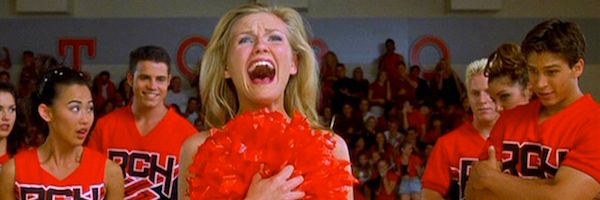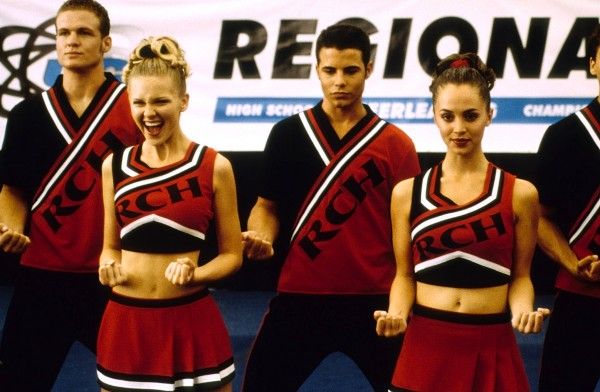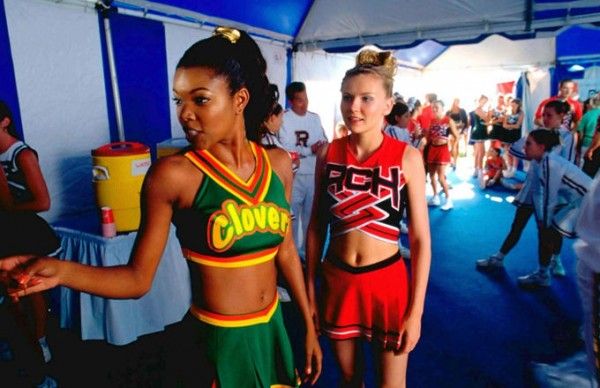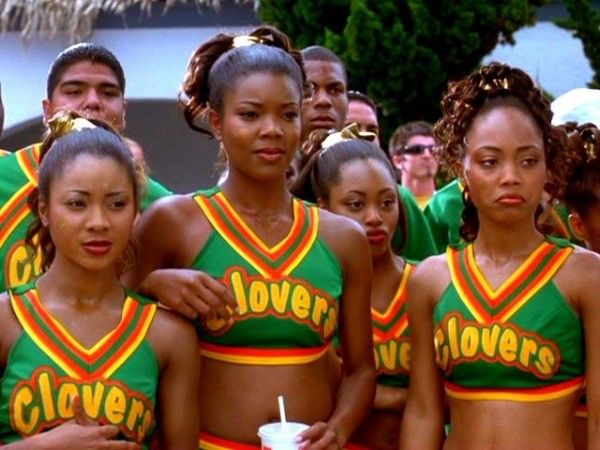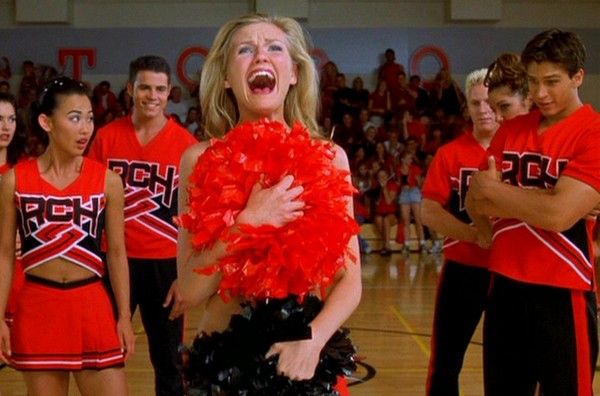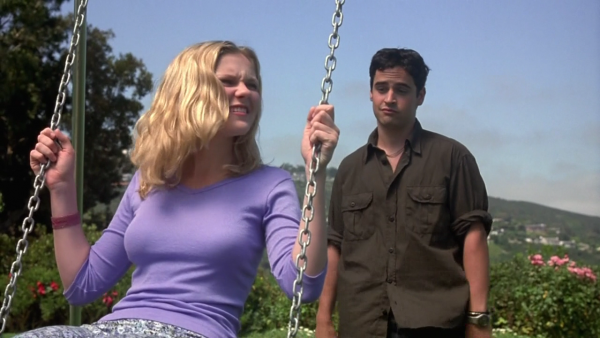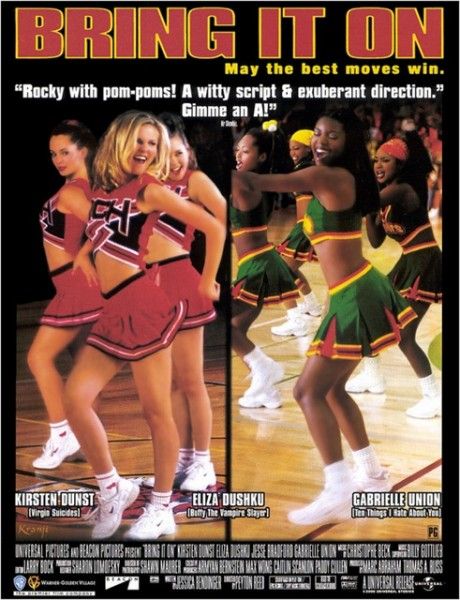I mentioned to a few people that I was planning on writing a piece about Bring It On for its fifteenth anniversary, and I was mostly met with anniversary fatigue or a question of what intellectual extractions can you draw from that movie? The high school cheerleading comedy starring Kirsten Dunst was a modest success in 2000, grossing more than $60 million off of a $10 million budget. The original film launched four direct-to-video sequels that co-star Gabrielle Union told Complex Magazine were probably rented by dads. It also served as the biggest pop-culture calling card for director Peyton Reed when he was announced as the replacement for Edgar Wright on Ant-Man.
Bring It On is still very fun. It's spry, witty, mildly risque, blessed to be carefree, and both aware and accepting of young sexuality without ever been crass. But there are intellectual extractions that come from re-watching Bring It On today. Mostly, it comes from examining what is no longer present in modern film: the high school comedy.
The 80s and 90s had many high school comedies, and they were mostly boisterous and happy. The 80s were largely about secret crushes and the many attempts to get laid. The 90s teen flick expanded a little to goofball portraits of separate communal tribes within high schools and provided guides of how to navigate all those cliques. But what makes Bring It On especially unique is that—even though it creates new vernaculars and props up a pyramid of jokes—it also acknowledges the unofficial schooling segregation between the haves and have-nots, and extends its bubble from an affluent, mostly white neighborhood in San Diego to a dominantly black and Latino high school in Compton.
Reed's film examines the cheerleading tribe not as attractive accessories that simply hang on the arms of the football players (in fact, the Toro cheerleaders win more matches than their embarrassing football team), but as their own championship teams. Bring It On is perhaps the best post-Clueless high school film of its kind. Like Amy Heckerling's classic, Bring It On gave us a few new pop culture words (such as "spirit fingers", "cheer-ocracy", and "cheer-tator") but Jessica Bendinger's script doesn't feel as forced as many of the preceding 90s films that attempted to create new, hip teen-speak because Bendinger kept her lingo within one defined tribe.
Of course it's the shared language between two squads, San Diego's Rancho Carne Toros and the East Compton Clovers, that sets off the plot of Bring It On. You know the cheer routine, "Brrr... It's cold in here... There must be some _______ in the atmosphere."
If your brain instantly puts "Toros" in the blank you can only be forgiven once—because their routine is introduced to us first. After the badass-new-girl LA transplant, Missy (Eliza Dushku), drives the newly elected cheer captain Torrance (Dunst) up to Compton to a Clovers game to expose the Toros' previous theft of the original routine, the pale duo (mockingly called "Buffy's" by the Clovers, a nice meta-wink as Dushku played Faith on Buffy the Vampire Slayer, and well, Dunst shares some SMG perkiness and blondness) are confronted by the squad who originated the routine with an on-point question: "Were the ethnic festivities to your liking today?"
Bendinger and Reed navigate the social justness of the film with a natural and un-preachy subtlety that perhaps couldn't be done in a teen film today, and yet it probably resonantes more with current audiences. The previous Toros' captain (Lindsay Sloane) knew that the Compton squad couldn't raise the local funds to send their cheerleaders to national-qualifying tournaments, so her thievery would likely go unnoticed—or no one would believe the Compton cheerleaders over the suburban cheerleaders. When Torrance tells the rest of the squad that their four-time championship-winning routines were stolen, the team's response that "this isn't about cheating, this is about winning" sounds as tone deaf as the current #AllLivesMatter movement because it deflects the obvious social ill (here it's cultural theft presented as originality to boost college applications) to benefit the one's who already hold the more powerful positions in society.
#BlackCheersMatter. Torrance understands this and even raises money for the Clovers to go to nationals. But Isis (Union) doesn't want a handout. She instills pride in her squad by raising the money themselves so that the thieves don't get to feel better by being charitable. The Clovers are going to win with their own moves and see what the Toros are actually made of—when the socioeconomic playing field is level.
Whoa, that escalated quickly and became a serious read on a not-so-serious movie. But seriousness is teen cinema today.
Correction: There is no teen cinema today, not how it existed previous to Bring It On, anyway, when there was at least one PG-13 high school romp released a month, and even more hitting video shelves each week. Sure there's a classic every five years or so (like Easy A or Mean Girls) but that's a huge gap between films when you consider the rate of classic 80s and 90s teen comedies. Now there's only "young adult" cinema—which largely puts the fate of a collapsed world in the hands of teens to save—and achingly sorrowful indie films in sleepy Midwestern towns. Why are there no more breezy, bubbly films with teens worried about grades, crushes, and the odor of their breath? To put it frankly: why are there so few Bring It On's in the past decade or so of American cinema?
Let's zoom outside of America to answer that. First, teens aren't in the enclosed pop culture bubble that every previous generation has largely been in, which is extremely localized. Sure there was Internet in 2000, but there was not social media, nor the prevalence of a constant worldwide news cycle that informed a majority of teens that the world is actually pretty cruel to most people who live outside of certain bubbles. It's telling that most films involving teens today are set in a dystopia of servitude to uncaring dictators and center on revolutionary upheaval of said dictators. Or they're soul-crushing dramas about teens who know there's a far more interesting world outside of their sleepy town. The 80s and 90s were great economic times for America and most Americans didn't peer too far outside their bubble, and most 90s teen films had fun exploring these bubbles of obliviousness.
By crossing over from suburbia to Compton, Bring It On is kind of a bridge from the 90s teen film to the 2000s. In the 2000's—post-9/11, post bailouts, post-the Arab Spring, post-Ferguson—perhaps a bubbly high school ditty doesn't make as much sense as teens rising from the rubble to start building anew.
The other reason is simply that wordplay comedy—a big component of the 90s teen movie—does not translate to foreign box office. And as films pivot and cater more to lining their schedules with films that can flex muscle abroad as well, out goes wordplay, and in comes more action or more slapstick-based comedies.
Last year, I spoke with producer Sandy Stern, who produced two seminal teen movies, Pump Up the Volume in 1990, and Saved! in 2004, and who laments the extreme difficulty of creating an old fashioned high school comedy in modern cinema. “The whole ancillary market that used to exist in terms of DVD sales to rental stores and to fans is gone now," Stern said, and noted that Bring It On had four direct to DVD films. "Foreign sales is the only security blanket for cinema—but high school movies have never translated well overseas. The teenage vernacular is different from country to country, the school system is different, the high school comedy is impossible to sell to the world and so now your budget has to be minuscule. The high school comedy has disappeared.”
That, readers, is why we have anniversary posts for so many films, including Bring It On. Because dammit it's easy to miss a fun film that creates innocent sexual tension from a teenaged boy and girl swapping turns spitting out toothpaste in the same sink. And to laugh at the distinction of what constitutes the proper fluttering of "spirit fingers." And to remember that making someone a CD was once the most romantic gesture and that inserting SAT words into everyday conversation made you sound like an alien. Because right now our teen movies are under "total domination." And sometimes it's nice to just watch something familiar, that smells like teen spirit, and yes, is cheery. In that regard, Bring It On is still the poo, so take a big whiff.
Bring It On was released in theaters on August 25, 2000

